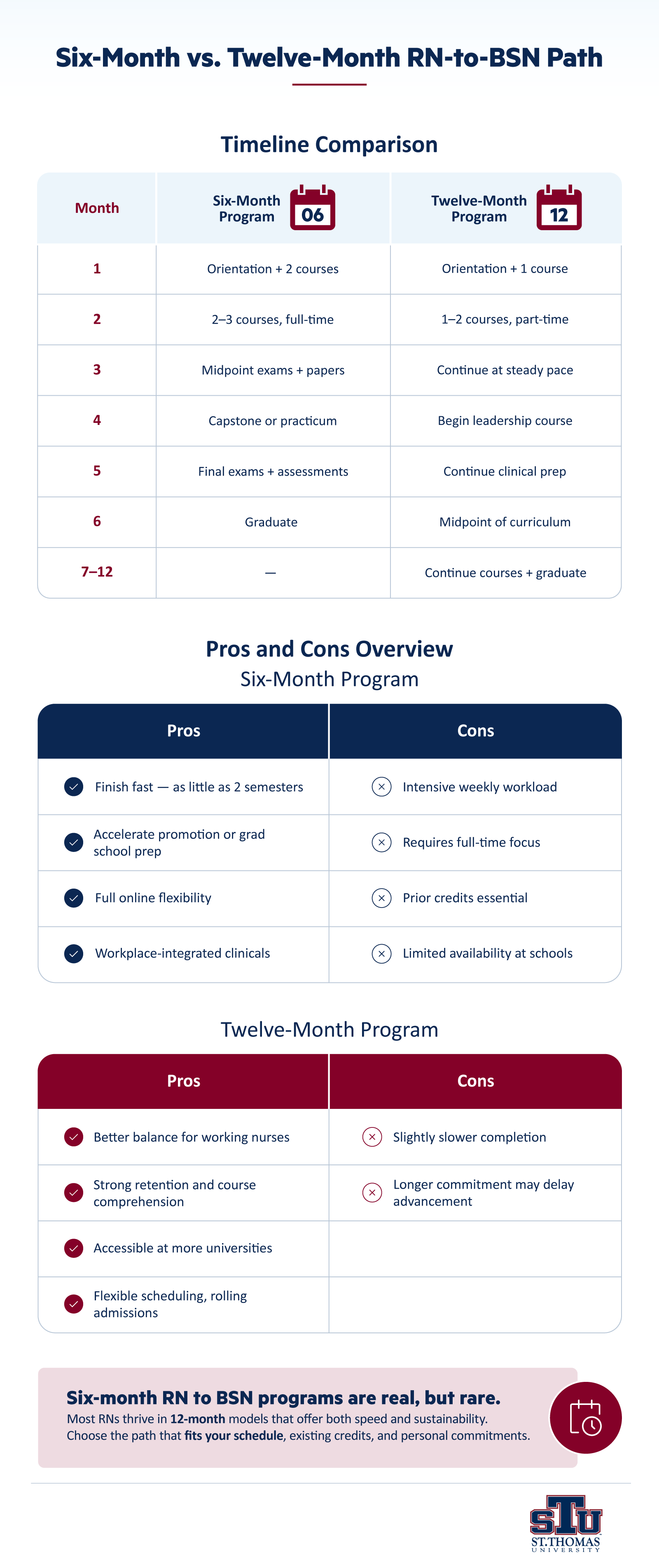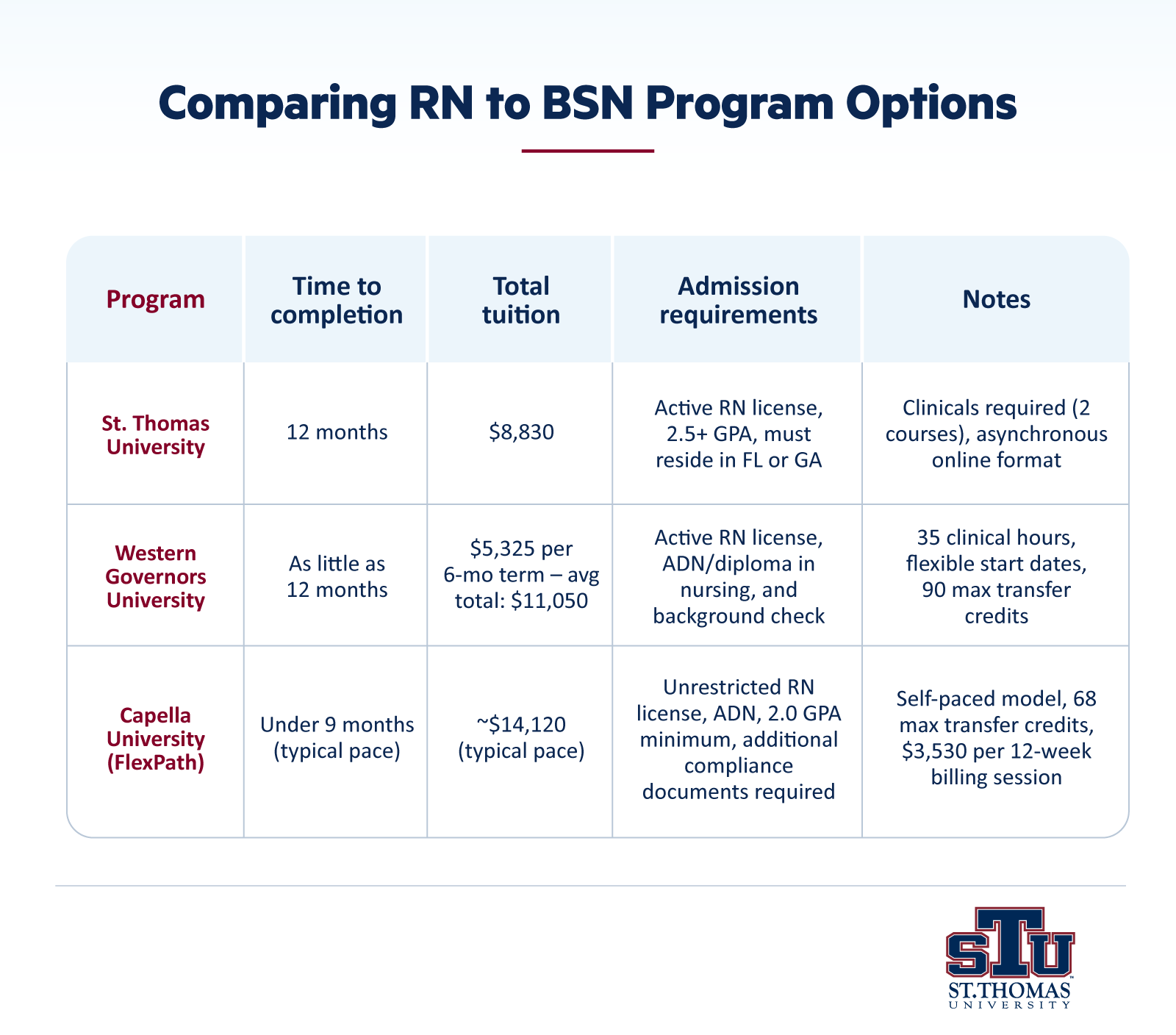
The demand for quick, career-advancing education has never been higher, especially for registered nurses (RNs) aiming to meet employer expectations and qualify for leadership roles. Among the most popular options is the six-month RN to BSN program, often promoted as the fastest track to earning a Bachelor of Science in Nursing (BSN). But is completing your BSN in just six months truly feasible?
While ultra-fast online programs promise a lightning-speed route, the reality is often more nuanced. Many of these programs come with fine print, ideal conditions or unrealistic workloads.
The online RN to BSN program from St. Thomas University (STU), for example, offers a competitive 12-month track that balances speed with structure. This model may be more attainable and sustainable for most working nurses. Before choosing a program, it’s necessary to separate myth from reality and explore what a fast-track RN to BSN program actually involves.

The Myth: Finish Your RN to BSN in Just 6 Months
The promise of completing a BSN in just half a year is undeniably appealing. For many RNs comparing Bachelor of Science in Nursing programs, the idea of a rapid timeline fits into a tightly packed life that already includes work shifts, family responsibilities and financial pressures.
- Speed to advancement: A six-month timeline means faster eligibility for leadership roles or advanced practice training.
- Cost savings: A shorter program could potentially lower total tuition and reduce time away from income-generating work.
- Flexibility for working nurses: Many of these programs are marketed as asynchronous, online and self-paced — ideal for professionals juggling multiple commitments.
In theory, these benefits seem to make the six-month BSN degree an ideal solution. But the reality requires closer inspection.
What’s Really Possible
Programs claiming a six-month RN to BSN completion are extremely rare and typically suited for a small group of highly prepared students. Many of these fast-track offerings rely on:
- Heavy transfer credit loads: Students must often bring in 60-90 previously earned credits.
- Full-time enrollment: Completing 30+ credit hours in just six months means doubling up on courses with intense weekly requirements.
- Minimal external commitments: To stay on pace, BSN students must often scale back work hours or eliminate outside distractions.
Most advertised six-month RN to BSN programs gloss over these details.
Case Examples
Several universities do offer programs that can be completed in six months, but only under ideal conditions:
- UT Health Houston markets a “BSN bridge in 2 semesters,” which equals six months if taken back-to-back with full loads.
- Capella University offers RN to BSN in “under 9 months” through its FlexPath self-paced format — but the six-month claim is only attainable if nursing students commit full time and bring maximum transfer credits.
- Western Governors University (WGU) allows for acceleration but does not guarantee six-month completion. Students finish “at their own pace” depending on prior credits and course availability.
While these institutions present accelerated options, most require rigorous time management and upfront planning. For the majority of nurses, a slightly longer but still fast timeline — like the 12-month pathway at STU — is more realistic and manageable.
The Reality: Most Fast-track RN to BSN Programs Take 9-12 Months
In nursing education, “accelerated” doesn’t always mean lightning fast. Most fast-track RN to BSN programs complete in nine to twelve months, not six. The term typically refers to a condensed format, not a guaranteed short timeline. Here’s what to expect:
- Condensed coursework: Classes are often seven to eight weeks long, covering material at a faster pace than traditional semesters.
- Rolling admissions: Many programs offer multiple start dates throughout the year to accommodate working nurses’ schedules.
- 100% online delivery: Coursework is designed for asynchronous completion, allowing students to log in and study on their own time.
Accelerated programs offer flexibility while maintaining academic rigor. They’re not a shortcut, just a different structure that works better for adult learners with professional and personal responsibilities.
STU’s Accelerated RN-BSN Option
St. Thomas University’s College of Nursing offers a fully online RN to BSN program that can be completed in as few as twelve months. It’s designed with working RNs in mind, combining flexible pacing with structured support. Highlights of the program include:
- Affordable tuition: Just $8,830 for the full 36-credit BSN curriculum, with no price difference for in-state vs. out-of-state students.
- Course length: Most courses are seven weeks long, with six-week sessions in summer terms.
- Comprehensive curriculum: Students take nine core nursing courses plus two university-required courses in Catholic identity and diversity.
- Clinical flexibility: While clinicals are required for two courses, students are encouraged to find local preceptors who fit their schedules.
Here’s what a typical yearlong course load might look like at STU:
| Sample 12-Month Schedule | ||
| Term | Courses (sample) | Notes |
| Spring 1 | NUR 411, NUR 415 | Start with the transition and system issues |
| Spring 2 | NUR 416, PHI 3633 | Ethics and research coursework |
| Summer 1 | NUR 417, NUR 418 | End-of-life patient care, health promotion |
| Summer 2 | NUR 419 (clinical), REL 2300 | Leadership, clinical and Catholic identity |
| Fall 1 | NUR 420 (clinical), NUR 421 | Community health and multicultural nursing |
| Fall 2 | NUR 422 | Final course in professional nursing informatics |
This format enables students to manage a full course load while working, especially if some general education credits are already completed.
Could a 6-month RN-BSN Work For You?
A six-month RN to BSN program isn’t impossible, but it demands near-perfect alignment between your academic history, personal life and professional flexibility. Only a small subset of nurses meets all the conditions to graduate in half a year.
Required Conditions
To complete a bachelor’s degree in six months, you’ll likely need:
- A large bank of transfer credits: Most accelerated tracks assume you’ve already completed all general education courses and bring in 60+ credits.
- Full-time availability: Expect to treat your studies like a second job — or even your main one — with 20+ hours of coursework
- Minimal distractions: Limited caregiving responsibilities, part-time work hours and a reliable study environment are essential.
- Academic readiness: Strong time management and independent learning skills are crucial for surviving the compressed format.
Even with all these factors in place, unexpected life events can derail a tight schedule, especially for adult learners.
Ideal Candidate Profile
Who actually thrives in a six-month RN to BSN program? Usually, it’s an RN who:
- Has recent college coursework in core subjects like English, math and sciences
- Is already working in a hospital that supports educational advancement or allows flexible scheduling
- Excels in time management and prefers self-paced, independent study
- Can integrate clinicals into their current job, saving time on placement and commuting
If that’s not your situation, there’s no shame in choosing a more practical timeline. The best program is the one you can complete without sacrificing your health, job or family life.
Why Most RNs Choose 9-12 Months
The majority of RNs opt for a nine- to twelve-month RN to BSN program for good reason: it’s fast without being overwhelming. This timeline supports a healthier work-life-study balance and improves retention.
According to the American Association of Colleges of Nursing (AACN), RN to BSN program enrollment has dropped nearly 10% year over year, partly due to burnout and unrealistic expectations. Flexible, structured programs like STUs help prevent dropout by providing achievable pacing and strong faculty support.
Ultimately, while a six-month path might look attractive, it often sets students up for stress or failure. A slightly longer program can still help you graduate fast and well prepared.

Fast Doesn’t Mean Easy: What To Expect in an Accelerated Program
Accelerated RN to BSN programs condense a full bachelor’s degree into a much shorter timeline, but the pace comes with pressure. Before enrolling in a fast-track option, it’s important to know the coursework demands, the approach to clinicals and the support you’ll receive along the way.
Core Coursework Breakdown
Even in a shortened format, RN to BSN programs cover essential nursing competencies designed to prepare you for advanced practice and leadership roles.
- Research and evidence-based practice: Learn how to critically evaluate clinical data and apply research findings to nursing care.
- Leadership and ethics: Courses like Nursing Leadership and Biomedical Ethics develop your decision-making and team management skills.
- Public and community health: Understand population-level health concerns and strategies for health promotion across diverse communities.
- Health informatics: Gain experience with digital tools used to improve patient outcomes and streamline clinical workflows.
STU’s RN to BSN program, for example, includes all of the above, plus specialized courses in multicultural nursing and healthcare systems.
No Clinicals? Maybe
Some programs claim “no clinicals required,” but that’s not always accurate. Many use workplace-integrated experiences in place of traditional clinical hours. That means you may be able to complete hands-on requirements at your current job, if your employer and schedule allow. At STU, two courses include clinical components:
- NUR 419: Nursing Leadership
- NUR 420: Community Health Nursing
Each requires 54 hours of clinical practicum. While students are encouraged to find their own preceptors, STU provides support if needed.
What Makes STU’s Online RN-BSN Program Stand Out
St. Thomas University’s RN to BSN online program is fast and thoughtfully designed to support working nurses through a manageable, meaningful academic journey. Here’s why:
- Asynchronous learning: Complete assignments and attend lectures on your schedule, not someone else’s.
- Faculty support: Instructors are responsive and experienced in guiding adult learners through online formats.
- Mission-driven education: With a Catholic identity and focus on diversity, STU emphasizes compassionate, ethical care in all health care settings.
The STU RN to BSN program does not require prerequisite courses to enroll. All general education requirements can be completed through STU online, alongside nursing courses, at the same affordable tuition rate and in the same accelerated format.
You’ll graduate not just with a new nursing degree but with the leadership tools, cultural awareness, critical thinking skills and advocacy skills needed to transform your health sciences career — and your patients’ lives.
Choosing the Right Path: 6, 9 or 12 Months?
Picking the best RN to BSN timeline depends on your schedule, transfer credits and goals. Here’s how to compare your options and make an informed decision. This high-level comparison shows how top degree programs differ in speed, cost and entry criteria:

Questions To Ask Before Enrolling
Use this quick checklist to evaluate whether an RN to BSN program fits your life and career goals:
- Do I have enough transfer credits to shorten my timeline?
- Will I need to work full time while in school?
- Is the coursework asynchronous and flexible?
- How are clinicals handled — and can I complete them locally?
- Does the program offer advisor support and tech help?
- Has a respected nursing body accredited it?
- Does it include the core courses required by my employer or state board?
Asking the right questions upfront can save time, money and frustration down the line.
Accreditation + Career Value
Accreditation is more than a checkbox — it’s your ticket to long-term career growth. Accredited RN to BSN programs are recognized by licensing boards and employers, as they meet rigorous standards for quality instruction and outcomes.
STU’s RN to BSN is CCNE-accredited (accredited by the Commission on Collegiate Nursing Education), which means:
- Employers will recognize the degree.
- You’ll be eligible for future advanced nursing degrees.
- Financial aid options are available.
- Clinical standards are aligned with national nursing practice
Whether you’re aiming for a leadership role or planning a DNP in the future, choosing an accredited institution is key to maximizing your return on investment.
Ready To Advance? Why STU May Be the Right Fit
If you’re looking for a fast but realistic, affordable but accredited program, STU offers a twelve-month RN to BSN that checks every box. You’ll get:
- A streamlined curriculum designed for working nurses.
- Expert faculty support and accessible advisors.
- Competitive tuition with no hidden application fees or other costs.
- A mission-driven education grounded in service and leadership.
STU’s online RN to BSN program is built to help you advance your nursing career without putting your life on hold. Take the next step: Request more info or apply now.

FAQs: What Nurses Ask About 6-month RN to BSN Programs
Even experienced RNs have questions when it comes to ultra-fast BSN pathways. Here are the most common ones — and clear, honest answers.
Can I really finish my BSN in six months?
Technically, yes — but only under ideal conditions. You’ll need a full load of transfer credits, near full-time study availability and zero interruptions. Most nurses find a nine-to-twelve-month path far more sustainable.
Will hospitals accept degrees from ultra-fast RN-to-BSN programs?
It depends on accreditation. As long as a body like CCNE recognizes the program, most hospitals will accept it. But some employers may view extremely short programs as less rigorous, so always verify their preferences.
What if I have to extend my schedule?
Most programs allow some flexibility. STU, for example, offers rolling starts and lets students take fewer courses per term if needed. If your schedule changes, communicate with your advisor early.
How do I transfer credits into an RN-BSN program?
You’ll need to submit official transcripts from prior institutions. Schools like STU accept up to 60 credits for general education and automatically award 24 credits for having RN licensure, pending a transcript review.
Can I take courses on campus if I prefer in-person learning?
STU’s program is 100% online and designed for flexibility. If you’re seeking an on-campus option, consider exploring traditional BSN tracks or hybrid programs that incorporate some in-person learning.
Will this program help with NCLEX prep, or is that only for ADN programs?
The NCLEX is required to become a licensed RN — typically passed after earning your associate degree. RN to BSN programs build on those foundations but do not include NCLEX prep, since you’re expected to hold licensure already.
Is there a capstone project or final practicum?
Many BSN programs, including STUs, include a capstone course or clinical practicum in leadership and public health nursing. These final experiences integrate everything you’ve learned and often allow you to work within your current job setting.
Will this program prepare me for a master’s degree or MSN?
Absolutely. An RN to BSN is the required stepping stone for advancing into an MSN or Doctor of Nursing Practice program. STU’s curriculum includes research, leadership, and professional development skills that build a strong foundation for graduate-level work.